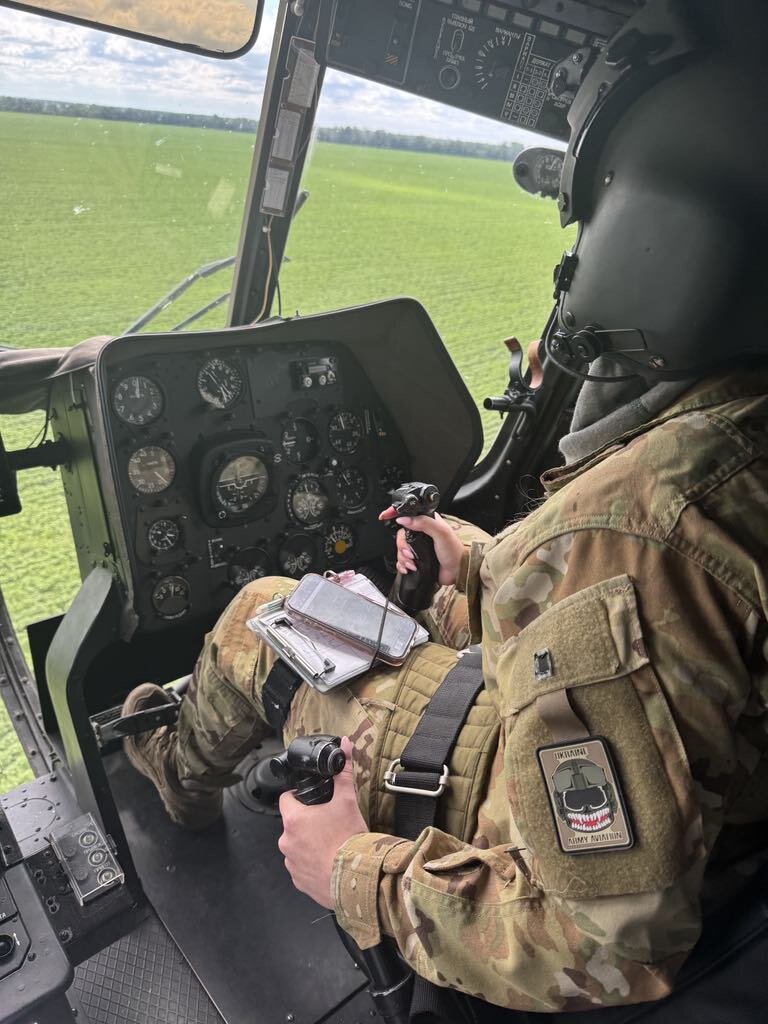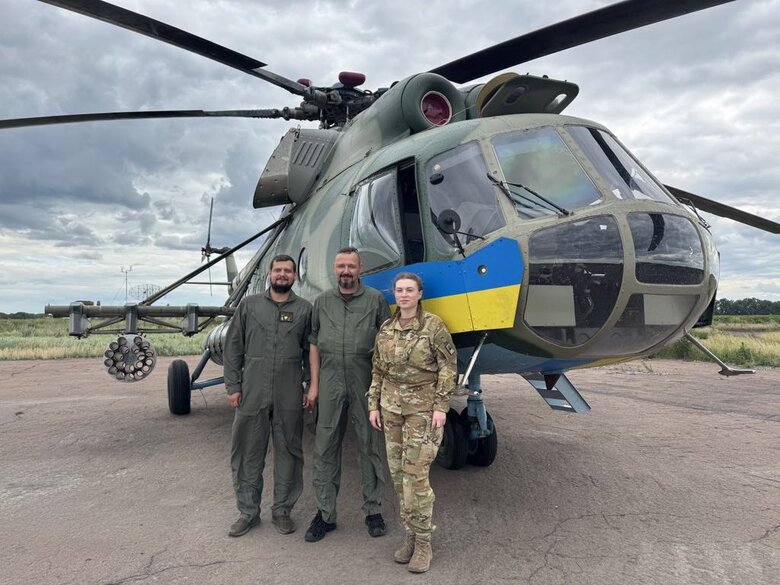"When people ask me what I do for living, I say I’m waitress. Why should everyone know I’m helicopter pilot?"
Kateryna is the only female pilot in the army aviation. For now, as professionals say, she occupies the right "seat." In time, she will move to the pilot-in-command’s seat.
She is only 22. Yet she deftly lifts a massive transport-assault helicopter into the air and scans the horizon, alerting her co-pilot: "Flock of birds to the right, tall power line ahead." Power cables, pylons, unexpected towers, all of them are hazards for helicopters that fly hugging the ground.
It’s not widely publicized that among the army aviation pilots, officially celebrating their founding day for the first time today, despite existing in Ukraine for 31 years, there is a woman. That’s why I was genuinely surprised when a young woman approached the crew commander we flew with to the Kharkiv region to deliver cargo to the infantrymen of the 28th Brigade. Katia focused calmly on gathering information about the destination point, clarifying details about the refueling location. Then she put on her helmet and took the right seat, for now, she is the co-pilot.
I am confident that the guys from the 28th Brigade, who received greetings from ordinary Ukrainians writing words of gratitude and support on the helicopter’s paper blades, didn’t even realize that behind the controls of the helicopter that landed in a field somewhere near Kharkiv was a very young girl, I can only describe Katia that way. Everything happened very fast, near the front line, you can’t linger long. Our helicopters are hunted so fiercely that even an Iskander missile wouldn’t spare them. That’s why the rotors never stopped. The entire meeting lasted no more than two minutes. So the guys on the ground couldn’t see Katia. Although her chest was adorned with cute reddish braids, it’s more convenient to braid hair under a helmet.
"I WAS NOT RAISED LIKE A SOLDIER"
- "I’ve been flying for almost two years," the pilot says. "I’ve been on rotation in the Kharkiv region multiple times. The missions vary. Older men sometimes pity me and say things like, ‘You’re just a girl.’ They try to offer me their hand when I get out of the helicopter, bring me something, or try to exempt me from combat duty. I always tell them I can do all that myself—I don’t need their pity. My peers or slightly older young officers emphasize gender equality and almost never take over tasks I’m supposed to do alongside them. And it’s not hard for me. I knew what I was getting into and why. Flying a helicopter is a job any woman can do just as well as a man. Takeoff and landing are the hardest parts. Everything else isn’t as difficult as it may seem.
But when I asked Katia how many girls trained alongside her at the Kharkiv Air Force University and how many took the pilot’s seat after graduation, I heard these numbers. In her class, there were nine other girls. However, most of them were in the moral and psychological support track. Only one became a helicopter pilot — Kateryna.
- "My father and mother both served in the military," the young woman says with a smile that seems to light up her face from within. The freckles softly covering her skin become more pronounced, adding charm to my interlocutor. Her greenish eyes sparkle with laughter even when she talks about serious things. "Dad often took me to the military airfield; I’ve been flying helicopters since childhood. I used to show the photos to my classmates. So, back in school, around ninth grade, I decided I would follow the military path and learn to pilot a helicopter myself. My parents only supported me. It’s my choice. They respect it and never tried to stop me."
In our family, there was never any militarism. Dad wasn’t strict with us. Although when I entered the Air Force University, many people openly and behind my back said, ‘Of course, her parents are military, she knows how to live in the barracks.’ But how would I know? We never lived in barracks. I wasn’t raised like a soldier.
We fly over fields, hopping over groves. The pilot-in-command occasionally hands the helicopter controls to Kateryna and points out how to perform certain maneuvers better. The young woman immediately follows the advice. She is attentive and focused. But when she spots a group of people in one of the fields who have abandoned their tools and, looking up at the sky, wave at the helicopter, both she and the pilot push aside their visors and wave back.
As we cross the Kyiv-Kharkiv highway, Katia recalls:
- We were once heading to the Kharkiv region, and our route was planned along this road. Then an Audi ‘tagged along’ with us. We were covering 220 kilometers. For a while, it tried not to lose us…
- Do you remember your first flight?
- Of course. At first, we trained on simulators for a long time, then flew the Mi-2. Later, the time came to take the co-pilot’s seat
Let me explain: a helicopter crew always consists of three members. The pilot-in-command sits on the left. His responsibilities include flying the helicopter and commanding the crew. The navigator, called the "co-pilot" is in charge of navigation, monitoring the route. There is also a flight technician responsible for technical maintenance, ensuring operational readiness, and refueling. Over time, the navigator in the right seat can and should move to the left "seat" as pilot-in-command. However, this does not happen in every case. To be fair, in the history of army aviation, two women have served as crew members, but none have yet moved into the pilot-in-command’s seat. So far.
THE INSTRUCTOR WHO ADVISED ME TO TRANSFER TO ANOTHER FACULTY WAS SURPRISED WHEN HE SAW ME AT THE AIRFIELD: "YOU FLY?"
- "When I first flew the helicopter, honestly, I didn’t understand anything," Kateryna says. "It was May 2022. In theory, you kind of know what you need to pull, but then you sit down and a ton of questions come up, including: what should I do? It’s not that I was scared. You just feel shocked—you can’t believe you’re sitting in a real helicopter, even though the instructor is right next to you. Then you focus on doing everything correctly. That’s when things start to work out. After my first flight, I got out of the helicopter with a wet back. But each time, it became clearer how everything works, what needs to be done, and how piloting goes. And the main thing—I really like it."
At first, we flew the Mi-2. When we moved on to the Mi-8, I met an instructor who advised me to transfer from the flight faculty to moral and psychological support. He was surprised when he saw me: ‘What are you doing here?’ I answered, ‘I’m here for practice.’ ‘You fly?’ ‘Well, yeah.’ Then he silently walked away.
- Did your parents discourage you from this profession, which at first glance seems purely male?
- They always supported me. Dad used to say, ‘Don’t listen to anyone. Why wouldn’t you be able to? Everyone flies, so why wouldn’t you…’ During our training, we had a female instructor. She flew the Mi-2. She told me, ‘Women manage just fine. You’ll do it.
When I notice that the pilot-in-command and the aircraft maintenance technician are wearing coveralls and start to suspect, finally, something might be edging toward "discrimination," Kateryna smoothly responds:
- I have the same flight suit, but it’s uncomfortable because it’s one piece," she adds. "It’s much more comfortable for men in their suits…
Her comrades nod in agreement.
From the helicopter cabin, you can clearly see not only neat and well-tended fields and gardens but also flags on the graves of Ukraine’s defenders. You can even make out freshly made graves with wreaths and flowers laid upon them.
- "I started flying during the full-scale offensive," Kateryna says. "Even then, I wanted to carry out combat missions. That’s the most important thing. For a year and a half, I’ve been participating in combat sorties. Mostly, I operated in the Kharkiv region. I flew repeatedly near the front line."
When I ask if she’s ever scared, she shrugs:
- ‘Then why did I train to be a pilot? To fly where? With the command’s condition that I only carry out missions in safe areas? Are there any safe places left in Ukraine now? I am ready and willing to do my job on equal footing with men.’
- When did you realise there was a war in the country?
- When Dad went to the ATO, it was 2014. He volunteered as infantry in the combined unit of the Ukrainian Air Force called " Dyka Kachka (Wild Duck)." He carried out missions near Donetsk airport for quite a long time. That’s when I realized our country was at war.
From the men’s joking stories, I know that being a pilot is a huge plus when meeting women: "When I say I fly helicopters, no one can resist." So I ask Katia if she brags about her profession when meeting young men.
- When people flirt with me and ask what I do for a living, I say I’m a waitress. Why should everyone know I’m a helicopter pilot?.
After the flight, back at the small airfield, the pilot-in-command reports the completed mission to leadership, the flight technician monitors the helicopter’s refueling and fills out paperwork, and Kateryna unexpectedly pulls out a ladder, grabs a window-cleaning spray, and starts wiping down the helicopter cabin from the outside, cleaning insect marks left during the flight. I take a photo of her, and she laughs:
- Post a photo like this online, and everyone will say I’m just here to clean windows.
The crew commander returns and explains: "Wiping the cockpit blister is the duty of the co-pilot. That’s how I used to do it back in the day. For now, Kateryna does it. When she becomes crew commander, it will be her co-pilot who does it. That’s the rule in our branch of the military."
- Katia, why did you choose a helicopter over attack aircraft?
- I like the feeling of flying. In an attack aircraft, the speed is different, so you don’t really feel the flight. And a helicopter has more capabilities; you can accomplish more tasks with it. A plane can only land on an airfield. You need a runway length to land. A helicopter can land anywhere — in a field, on a clearing.
During our flight in the area where we were, an air raid alert started. From those controlling the situation on the ground, Kateryna received an order to land the helicopter. The crew commander immediately found a convenient clearing, hovered above it — and for a short time, the aircraft touched down. As soon as the alert ended and ground control gave the go-ahead for takeoff, we continued our movement.
- I am well aware that I am not the first female helicopter pilot. I’m just the only one right now. But I would really like more girls to fly.
...…Today, our country officially celebrates Army Aviation Day for the first time. We want to congratulate all members of this military branch and thank them for their work and defense of Ukraine.
To support the only female helicopter pilot, we are launching a fundraiser for her helmet. The state provides pilots with necessary equipment, but experienced pilots purchase personal gear. Kateryna dreams of such a helmet. And she has already earned it — each of us should show our gratitude for her choice by supporting her in this way. So, we are sharing the bank details.
Link to the bank
https://send.monobank.ua/jar/3k1bCZqzGW
Bank card number
4441 1111 2572 1807
Violetta Kirtoka, Censor.NET





